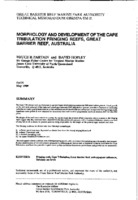Please use this identifier to cite or link to this item:
https://hdl.handle.net/11017/210

| Title: | Morphology and development of the Cape Tribulation fringing reefs, Great Barrier Reef, Australia |
| Authors: | Partain, B.R. Hopley, D. Great Barrier Reef Marine Park Authority |
| Keywords: | Coral reef and islands;Holocene sea levels;Fringing reefs;Great Barrier Reef (Qld.);Cape Tribulation |
| metadata.dc.subject.asfa: | Fringing reefs Geomorphology Anthropogenic effects Lithology |
| APAIS Subject: | Geology Surveys |
| metadata.dc.subject.category: | Processes Research |
| Year of publication: | 1989 |
| Publisher: | Great Barrier Reef Marine Park Authority |
| Series/Report no.: | Technical memorandum TM-21 Technical memorandum series |
| Abstract: | on the reef crest and most of the back reef ceased approximately5400 years before present, probably in response to increasing turbidity and water quality deterioration as fine sediments accumulated offshore and became resuspended during strong winds. Significant coral growth is now restricted to the subtidal fore reef but reef progradation has been minimal over the last 5000 years.The height of the reef crests relative to present day sea level and the absence of low magnesian calcite cements in the fringing reefs suggest that they have not been subjected to extensive subaerial exposure, with a maximum Holocene relative sea level of only 0.6 to 1.0 m above its present position being responsible for the height of the present algal covered reef crest. The fringing reefs can be divided into four lithologic assemblages: i) a fluvial gravel basement deposited as alluvial fans from the steeply sloping hinterland ii) a lower framestone unit iii) a detrital assemblage and iv) an upper framestone-bandstone unit. |
| URI: | https://hdl.handle.net/11017/210 |
| ISBN: | 9780642120267 |
| Type of document: | Report |
| Appears in Collections: | Management |
Files in This Item:
| File | Description | Size | Format | |
|---|---|---|---|---|
| Morphology-development-Cape-Tribulation-fringing-reefs-GBR.pdf | main report | 18.76 MB | Adobe PDF |  View/Open |
Items in ELibrary are protected by copyright, with all rights reserved, unless otherwise indicated.
